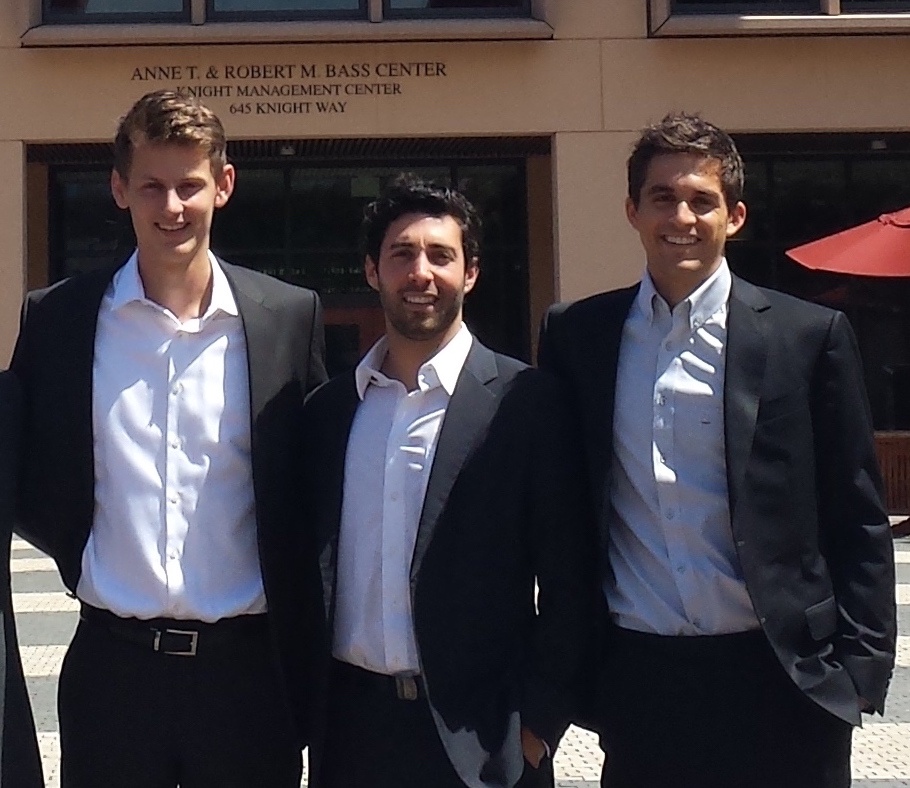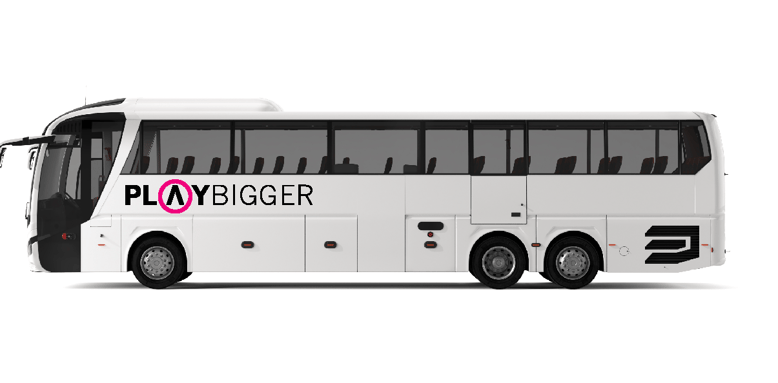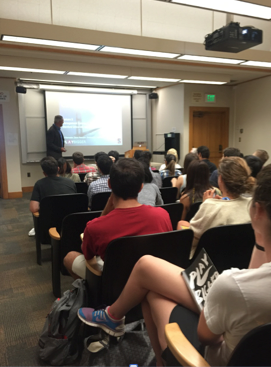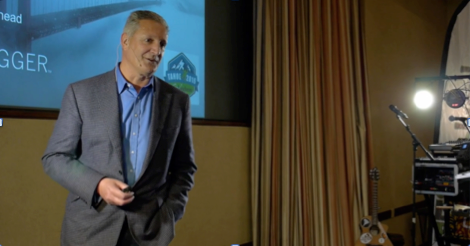
The problem is clear. Global shipping logistics is broken. Adam Compain and his band of ClearMetal geniuses from Stanford are going to fix it.
Here's their story.
First of all, let's clarify what we mean about the shipping logistics problem. We are talking about the problem, highlighted in a recent Forbes article, of moving more than 18 million shipping containers, carrying the bulk of all goods produced and sold in the world, across 10,000 port calls per week, representing a total value of more than $4 trillion annually. It's big.
When we met Adam, Will and Diego at their office in San Francisco, we asked what we always ask - "What problem are you solving?" After a few hours, and two whiteboards later, the answer left us quite stunned. (BTW - Will is pictured below on the left, Adam is in the middle, and Diego is on the right).

Turns out that moving giant metal containers is a highly manual process. Some of the smartest shipping logistics people on the planet were literally taking educated guesses on what containers go where and when. Every week. On whiteboards, and paper, and Excel spreadsheets, using the most basic of forecasting models.
So, we then asked Adam and team, what are the ramifications of not fixing this problem? Flash forward to another hour long conversation and another whiteboard of notes. First of all, easily 1 out of 5 containers in the world is traveling empty. Empty containers represent more than $15 billion in revenue losses a year. And these container ships are responsible for 3% of all global carbon emissions.
- A single mid-sized carrier could spend $750M on global equipment and repositioning cost each year.
- In the US, alone, carriers can spend >$1M per week moving empties out to the coasts.
If that is not bad enough, carriers have to deal with ever changing demand from the "shippers", which is lingo for retail and manufacturing companies like Nike, who use these containers to ship their stuff around the world. If a shipper changes their order at the last minute, there is not much a carrier can do except eat the cost. Lastly, throw in the effort to predict weather, such as how hurricanes (Al calls them cyclones) impact delivery times, and you have a giant problem that is currently unsolvable with pencil, paper, and spreadsheets, or with antiquated, inaccurate logistics software that cannot ingest modern shipping data.
Then, we asked how the hell these guys were going to solve this problem. This was the moment the pirates of ClearMetal started beaming. Turns out that moving metal is a big data problem not a shipping problem. Specifically the answer lies in a data science method called predictive analytics and intelligence. Adam, Will and Diego invented a predictive intelligence engine that could calculate millions of possible factors involved in shipping including weather, order patterns, seasonality, fuel prices, shipper (retailer) behaviors and patterns, and more...Their plutonium would then calculate where every container would be and should be around the world...down to the day and specific container yard.
In the world the rest of us live in, this may not seem that big of a deal. We can order Amazon stuff and it arrives that day. But in the world of shipping, this type of solution was met with massive disbelief. Shipping is a world where you over provision (putting extra containers on the ship) by a huge factor. Said another way, marginal increases such as a a single percentage of utilization yields millions of dollars. Or one marginal error, like a single wrong prediction, can accumulate to tens of thousands of containers sitting in excess and incurring global costs each year.
So, how did the ClearMetal crew go about convincing a very conservative and slow moving shipping industry that there is a new way to move metal around the world? They launched a lightning strike announcing the ClearMetal Predictive Intelligence Platform and defined the new category of Predictive Logistics. They picked the Trans-Pacific Maritime show in early March in Long Beach, CA to unveil the category and their solution. The TPM show is the biggest event of the year for the global shipping industry.
Adam and crew understood that category design is a mind game as much as anything. If you can get to the few influencers that matter, frame the problem with conviction, and demonstrate a new category of solution, then you are setting yourself up for success.
Those influencers were at the TPM show, and everywhere they went, they saw Adam and ClearMetal. Grab a cup of coffee and you saw the ClearMetal booth and demo. Attend the Big Data session, and Adam was introducing the session on Supply Chain Data & Visibility. Sit down for the main event, and you found a ClearMetal whitepaper defining the new category of Predictive Logistics under your butt. Search for ClearMetal on Google and up pops their shiny new website.
The pièce de ré·sis·tance of the ClearMetal strike was their funding announcement. It's one thing to talk about your new category and solution, it's an entirely different result when you announce that NEA, Skyview, and (Google Chairman) Eric Schmidt's Innovation Endeavors backs you.
The ClearMetal vision for the predictive logistics management category also stuck hard as evidence by what Forbes and Inc. had to say.

A New Big Data Predictive Analytics Solution For Ocean Carriers
In logistics, we have not seen all that many examples of Big Data analytics. Using a demand forecast at the store level to create transportation plans -Terra Technology and JDA do this in different ways - would be two examples. Until recently, I would have been hard pressed to come up with another example.
That has changed. I recently had a conversation with Adam Compain and Will Harvey, the cofounders of ClearMetal. Mr. Compain is the CEO, Mr. Harvey is the Head of Technology. ClearMetal is applying predictive analytics to help Ocean carriers improve their profitability through better placement of ocean containers and more efficient vessel space planning. They recently received $3 million in seed financing round from NEA, Skyview, and Innovation Endeavors.

Here's the Fastest Way to Get Packages to Your Front Door (No, It's Not Drones)
A new logistics company wants to speed deliveries by easing shipping bottlenecks around the world. And with investment from Google's executive chairman, it just may work.
ClearMetal has the hard yards in front of them to move the entire shipping logistics industry from spreadsheets to Predictive Logistics. But if you spend more than 10 minutes with Adam, Will and Diego, it's easy to place your bets that they will get the job done.
Who knows, if they can fix logistics over the ocean, then maybe the land and sky may be next on the list.
CATEGORY DESIGN TOUR

If the Play Bigger crew looks a little haggard, it's because in addition to helping our clients become legendary category designers, we have been on tour teaching, lecturing and sharing everything we know about category design.
Stanford University
A few months back, Al started talking with Ann Miura-Ko about delivering a series of lectures for her Masters of Management Science and Engineering at Stanford University. Ann and her partner Mike Maples from Floodgate had developed a fascinating model for tech startups. They call it their tower of power. At the top of the stack is what they call Category Power. Ann walked us through their model and we instantly connected with it. So much so that we started brainstorming on how the emerging discipline of category design and our research on category kings might become a part of the Stanford MSE275 curriculum.
Ann and Al collaborated and developed a three lecture series introducing our most recent understandings on category kings and the process of category design. As part of the lecture series we assigned the students to do a category design assessment of a very high profile tech unicorn, asking them if the CEO had done a good job of category design and what recommendations they would have for the CEO.
It had been a while since Al had been on the Stanford Campus. He spent a summer studying back in 1995. As he walked to the Main Quad for the first lecture a whole set of memories flooded back. The Exec Program, the founding insight for Quokka (that data would become as valuable as video in sports), and the early business model discussions that happened on campus.
It was a little emotional walking into the lecture theater. Fifty of the brightest minds in software engineering and management science were staring back at Al as he started walking through the research findings. All of the big topics hit the table including how category economics drives 76% of the market cap to the category king, the 6-10 Law, and the category lifecycle model. Dozens of questions and answers flying back and forward... At the end of the 80 minutes the teacher's assistant called timeout and the lecture came to a close. The subsequent lectures had a similar feel, and in the end, our first class of category designers made us all proud. Many of the students made comments like "As a student in this class, I can attest to the fact that the idea of category design and category kings is about to become the next hot topic. I love the book! And Mr. Ramadan should consider a future in teaching".
One thing is clear, when this class of category designers graduate in June, the odds of becoming a category king will increase for those companies lucky enough to employ them.
It was an honor and a privilege to work with Ann and Stanford on this project. It's no surprise that Forbes calls Ann the #1 woman in venture capital.

Sequoia, Accel & Venrock Workshops
In addition to our Stanford lecture series, we wanted to fine-tune our new category design workshop product, which we will begin delivering in mid summer. We were stoked to partner with three of the finest VC in our industry and drive a discussion with almost 100 entrepreneurs from leading tech companies in the Bay Area and New York.
We delivered three sell out category design workshops. Each venture capital firm on our tour hand-picked a number of their portfolio companies to participate. The workshops were fast paced, dynamic and full of lively discussion and debate. We continue to believe that many entrepreneurs are natural category designers and practice the discipline instinctively...and these workshops are a really powerful way to arm all of these leaders with the playbook for success.
GoBundance and EY Innovation Realized
On our tour, we also paid a visit to 200 small business entrepreneurs to explore how category design applied to businesses outside of technology.

Al was a keynote speaker at the Annual Gobundance meeting at Squaw Inn in January and we captured this short video of the highlights. He presented to over 200 entrepreneurs and small business owners on the category king game and the Play Bigger category design playbook.
Al shared some of the most recent Play Bigger research findings and the HBR story. He also discussed the building blocks of the Play Bigger playbook and the excitement of the crown pushed Q&A late into the night.
Christopher also spoke at the EY Innovation Realized event at Pier 70 in San Francisco. This two day retreat hosted hundreds of innovators, strategists, and business leaders to discuss new ways of thinking about the business working world. Chris shared highlights of our category design research and why it matters to build a great product, company and category at the same time.
The Experience Matters POV is Back and Triving!
Adobe held their annual Digital Marketing Summit at the Venetian Palazzoon on the Las Vegas Strip this week. It was an outstanding event with over 10,000 marketing professionals attending. Social media came alive among some old time Macromedia folks when Adobe introduced Adobe XD centered on the "experience matters" point of view.
Al, Chris and Dave were part of the team who wrote the original Experience Matters manifesto back in 2004 and it was awesome to see it still thriving 12 years later. It demonstrates that great POV's have a long shelf life when done right.
One of the Macromedia folks dug up the original Experience Matters video which is still a great example of a powerful Point of View. Also, check out the Adobe experience matters announcement for more details on the Adobe XD lightning strike.
